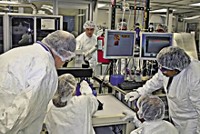Advertisement
Grab your lab coat. Let's get started
Welcome!
Welcome!
Create an account below to get 6 C&EN articles per month, receive newsletters and more - all free.
It seems this is your first time logging in online. Please enter the following information to continue.
As an ACS member you automatically get access to this site. All we need is few more details to create your reading experience.
Not you? Sign in with a different account.
Not you? Sign in with a different account.
ERROR 1
ERROR 1
ERROR 2
ERROR 2
ERROR 2
ERROR 2
ERROR 2
Password and Confirm password must match.
If you have an ACS member number, please enter it here so we can link this account to your membership. (optional)
ERROR 2
ACS values your privacy. By submitting your information, you are gaining access to C&EN and subscribing to our weekly newsletter. We use the information you provide to make your reading experience better, and we will never sell your data to third party members.
Environment
Polymer School Set To Rise In India
Industry association joins with U.S. universities to create a university for plastics engineers
by Amruthanand Nair
March 12, 2012
| A version of this story appeared in
Volume 90, Issue 11

The polymer engineering research center of the University of Wisconsin, Madison, is teaming up with the department of plastics engineering at the University of Massachusetts, Lowell, and an Indian plastics association to design the curriculum for a new plastics-oriented university in India.
India’s plastics processing capacity is expected to more than double to 20 million tons per year by 2020, creating an estimated 7,000 jobs for trained plastics engineers and other personnel. To sustain the industry’s growth trajectory, the trade association Plastindia Foundation has joined with the two U.S. universities to ensure qualified and skilled manpower.
The UMass Lowell plastics engineering department, founded in 1954, is one of the most prominent in the country. The universities and their Indian partner see an opportunity to build an engineering program in India that focuses on practical areas such as manufacturing, entrepreneurship, and innovation.
That’s something India’s educational system isn’t doing, they say. “Indian students who graduate with a B.S. engineering or science degree are highly prepared on theory but lack the practical manufacturing, processing, and testing experience, and they lack a business background,” says Nick R. Schott, emeritus professor at UMass Lowell. “We love these students, because they are well prepared analytically. We, in turn, aim to give them the applied courses and hands-on experience.”
Tim A. Osswald, codirector of the Polymer Engineering Center in UW Madison’s mechanical engineering department, notes that the university will provide “training in an area that is growing. India today produces about 4% of the world’s plastics products and is growing at a rate of 12% per year.”
To be called Plastindia International University (PIU), the school will be built with a $30 million investment that comes primarily from India’s plastics industry. Ground will be broken later this year, and classrooms are expected to open three years later.
PIU will be located on 50 acres in Vapi, Gujarat state, one of India’s largest plastics manufacturing regions. “Western Gujarat has a lot of polymer processing units. The north of Maharashtra and south of Gujarat process and convert nearly 25% of the plastics products in the country. It was an ideal spot,” says Bipin Shah, vice president of Plastindia Foundation and director of the Indian packaging maker Trend Pack.
Plastindia Foundation’s goal is to grow India’s technically skilled workforce by training people closer to home. And to do that, executives realized that they needed to reach out to schools outside India that have experience teaching and doing research in plastics. “Plastindia Foundation felt that the Indian system does not allow flexibility in the curriculum,” Schott says. “We have close to 60 years in which we developed ours,” referring to UMass Lowell’s program.
PIU will provide undergraduate programs in polymer processing, engineering, R&D, and management education, in addition to those related to mechanical engineering, industrial research, project management, and entrepreneurship, Shah says. It also plans to establish dual-degree programs and, ultimately, doctorate-level programs.
“Indian students who study at PIU will be exposed to a curriculum and philosophy that emphasize manufacturing and entrepreneurship,” Schott says. “We are discussing cooperative opportunities for Indian students who are at UMass Lowell and can then do internships. We are also willing to help design the labs and help with the staffing needs at PIU based on our experience.”
In addition to creating opportunities for prospective plastics engineering students in India, the new institution will also open its doors to UMass Lowell and UW Madison students seeking engineering experiences abroad. “We plan to have a healthy exchange of faculty and students going back and forth,” UW Madison’s Osswald says. “This will help students to think globally and in an international way. Also, the growing industry in India will give students plenty of opportunity to do co-ops and internships.”
Schott traces the origins of PIU back more than a decade. “In the 1990s, plastics industrialist Nirmal Thakkar of Tipco Industries, the father of two of our Indian alums, first came to UMass Lowell and broached the subject of an independent university,” he says. Several discussions later, and after visits by Plastindia members, a memorandum of understanding was signed on Feb. 3.
Plastindia’s Shah is himself a chemical engineer, trained in plastics processing in the U.S. He still speaks fondly of the 1960 textbook “Transport Phenomena,” authored by UW Madison chemical engineers R. Byron Bird, Warren Stewart, and Edwin Lightfoot.
Times have changed since then, but some needs are timeless. “The need of the hour is a skilled workforce,” Shah says. “We will be able to offer online training and evening courses by this September. The university should have 1,200 students in five years’ time.”




Join the conversation
Contact the reporter
Submit a Letter to the Editor for publication
Engage with us on Twitter